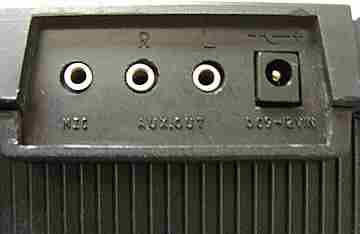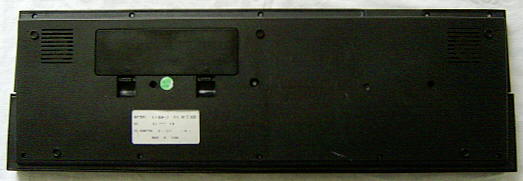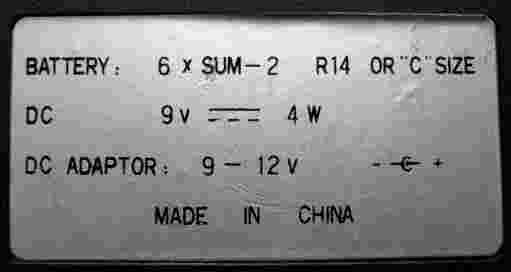| digital squarewave keyboard with C64 sounds & accompaniment |
|
This squarewave keyboard seems to be a technically simplified single-chip successor of MC-3 hardware. Sounds and features are basically very similar, but the rhythms have 2 sets of accompaniment patterns, those are also the most interesting new feature of this instrument, because they contain very unique, glitch- like bursts of short, blippy notes, like when a freaked- out arpeggio would play only during the pauses between normal chord notes.
The Penrod AJ-430 also has an additional primitive sequencer (monophonic record & playback). Unfortunately the separate chord volume slider and the manual bass mode were omitted. This instrument was also released as Satellite AJ-430 (and possibly others). The AJ-430 resembles very much Letron MC-3, thus I only describe here the differences.
 |
 |
 |
 |
The OBS preset sounds of the Penrod AJ-430 sound very much like on MC-3, although they are in different order and partly misspelled. Even their synth parameters and corresponding output pins seem to be an exact match of the original MC-3 (verified by oscilloscope). But because 'violin' and 'saxophone' only differ in the output channel and in AJ-430 no different filters exist, they here sound exactly the same. (You may install a capacitor to change this.) Unlike MC-3, the OBS preset sound buttons here respond a little slow and thus are less suited for realtime play tricks.
Also the percussion sounds like MC-3, but the preset rhythm patterns differ and play a little choppy. The "rock 'n' roll" pattern seems to be rather a mislabelled tango. With my specimen the maximum rhythm volume was a bit low. Like the MC-3, the AJ-430 has nice accompaniment made from squarewave organ + e-bass(?) tones, but unlike the MC-3 it has a variation button (misspelled "viriation") to select a 2nd set of more complex accompaniment patterns. These patterns sound nicely bizarre and somehow broken because they contain between the normal chord notes bursts of short blipping notes, like when a freaked- out arpeggio would play only during the pauses between normal notes. The only other keyboard I heard with similar styles is the bizarre Ramasio 892.
The monophonic record/ playback sequencer can not be combined with rhythm or chords and has a quite low timing resolution. (But unlike My Music Center it at least doesn't erase its contents when other functions are selected.) The 2 demo melodies repeat each in a loop and switch only by pressing the demo button again.
The "500 Miles Away From Home" tune resembles the well known MC-3 one,
but contains an additional pattern with varied phrasing that alternates
with the normal one. The 2nd melody is a short monoto that sounds between
a western movie theme and something Chinese; on eBay someone listed
its name as "Sound & Smile".
circuit bending detailsThe Penrod AJ-430 appears to be a cheaper version of MC-3 hardware, because despite very similar features it has the DSG-MC-3 sound IC integrated into the CPU "CIL-51" (crystal clocked @ 4 MHz). Like a DSG it still has the separate sound outputs for drums, hihat+snare, bass, chord and 2x main voice, and the sound set is programmed the same.
When I bough this instrument (used, from eBay), it hummed very badly at low volume setting and distorted at higher volume. I found out that it hummed due to bad GND wiring; I fixed this by soldering a thick wire from GND at the AC adapter jack to the GND pin of the power amplifier IC. Later it turned out that the 220uF electrolytic cap of the power amp was bad. After replacement it worked well, but the instrument sometimes does not reset properly (does nothing after power-on), so I also replaced the electrolytic 1uF reset capacitor with a more reliable foil cap. When I had set the AC adapter volume to 9 or 12 volt (like indicated on the jack), the amp worked well, but the sound envelopes started to fluctuate and got stuck at full volume as continuous tones (see CIL-51 for exact behaviour). The instrument freaked out at the 7.5V setting of my unregulated AC adapter because the +5V voltage of the CPU was badly stabilized by a 5.6V zener diode "BZX85C 5V6" and a transistor, and thus ascended to >5.1V when input voltage was set high enough to make the amp work properly. Possibly someone damaged it by wrong polarity, because instead of a protection diode there was only a wire bridge soldered in. To fix this, I soldered a 47 kOhm trimmer in series to the (slightly burnt looking) 500 Ohm resistor that is wired parallel to the zener diode. By adjusting the trimmer, I found out that the CPU even works well with only 3.5V, but the envelope control of mine freaks out as soon the voltage rises only slightly above 5V. For normal use set it to about +4.7V as a safe value. (Lower is quieter and drowns in the hum of the amp.) The stuck envelopes at 5.1V may be suitable as a sound effect (they warble louder and quieter at a threshold voltage), but I don't know if this is safe, because overvoltage can cause chip cancer over time (known e.g. from overclocked Pentium PCs). At least the CPU in my keyboard did not run hot from it, and the margin between 5.0 and 5.1V does not look terrifying. separate volume controlsAn annoying limitation of the Penrod AJ-430 is that it has no separate accompaniment volume controls. But the CPU still has separate sound outputs {drums, snare/ hihats, bass, chord, main 1, main 2} at pins 2 to 7, thus separate faders for the individual tracks can be easily added. The main voice is output through 2 different pins depending on the selected preset sound; likely these were intended to be muffled differently by external filters. With my specimen I yet only soldered a 100 Ohm resistor parallel to R39 (10 kOhm) on the potentiometer PCB to increase the (quite low) rhythm volume.keyboard matrixThe keyboard matrix layout blatantly resembles MC-3 hardware, so the PCB was likely designed as a direct replacement, but nevertheless there are plenty of eastereggs. The lots of empty places do nothing.
The input lines are active- low, i.e. react on GND. Any functions can
be triggered by a non- locking switch in series to a diode from one "in"
to one "out" pin.
The matrix outs 26..32 can additionally drive each a panel LED through a transistor; for this the pauses between the short scan pulses (when the inputs are active) are pulled lo to light the LED (else hi).
The most interesting eastereggs are the 4 additional OBS preset rhythms at {24,44,45,46}->32 due to the unusual alternative accompaniment patterns selectable by the variation button. The additional rhythms were named after those on Superb Sound EK-902 (see below); the "samba" sounds more like beguine, the "tango" more like heavy metal.
A button at 43->33 plays a rhythm fill-in pattern.
A button at 39->30 permits to play in the chord section a monophonic manual organ bass (sawtooth) instead of accompaniment. Unlike MC-3 here the main voice even stays 3 note polyphonic.
A button at 46->33 adds a slightly weaker vibrato than the normal one.
The "transpose b" button at 43->30 pitches the keyboard down in semitone steps (works only with accompaniment?). The "transpose reset" button at 24->30 transposes back to normal (not needed because the transpose button can do this too).
A button at 46->34 steps through the sequencer contents note by note (works even during demo), which mutes the keyboard until the sequence is finished.
Buttons at 44->34 and 45->34 start both demos individually. pinout CIL-51The "CIL-51" (48 pin DIL) is the single chip CPU of Penrod AJ-430. It was obviously designed to replace the MC-3DX CPU with separate DSG-MC-3 sound IC of MC-3 keyboards while keeping the same functionality. Even the keyboard matrix layout is similar. Waveforms and envelopes of the internal sound generator look like the classic DSG. Additional to the original MC-3 concept it supports 4 additional rhythms with accompaniment variation button, 2 vibrato depths, 2 demos and a "one key play" button. Unlike a real DSG, the sawtooth waveform is only 15 steps high, which indicates a crippled waveform DAC with only 4 instead of 5 bit. Also the envelope may be grainier.By lack of schematics, all pin names were chosen by me (partly inspired
by Casio naming conventions and the DSG YM2163).
So do not depend on them - they may change if I find schematics or an official
datasheet.
This CPU does not tolerate supply voltages above +5V. While my specimen works already at +3.5V, anything only slightly above +5V makes the volume envelopes get stuck. Despite the volume envelope has digital zipper noise steps, when supply voltage +Vs is risen slightly above 5V it immediately stops decaying and gets stuck where it is; at 5.1V it even turns a little louder because the output level proportionally(?) increases with voltage. Once +Vs is set below 5V again, it continues decaying from its actual level. This can be repeated many times, and even during stuck envelope a new key press will make the volume level immediately rise to attack level of that preset sound and stay there until +Vs is set low enough to decay again. The tone generator stops the channel once the envelope reaches zero (no matter how long this takes). At the threshold voltage of 5.05V there is a strange flutter on the stuck envelope and static noise on the output, which clearly indicates that it is an analogue phenomenon. Percussion envelopes are not affected. My theory is that the volume envelope of each main voice channel inside the CPU is implemented by a VCA driven by an internal envelope capacitor, which is charged or discharged by short current pulses at a certain rate (PWM, similar like the external capacitors in Hing Hon EK-001). While +Vs has risen above 5V, the internal pulldown transistor stops working (by a zener diode effect?) and so the capacitor voltage at the VCA stays where it is. But the envelope stays in decay mode (generating discharge pulses) until a comparator detects that the output has reached zero, which will stop the tone generator to free the channel. Because the waveform DAC is time multiplexed among polyphony channels (seen on oscilloscope), likely the 4 envelope capacitors are switched like a BBD while the rest of the envelope circuit only exists once. Another evidence for the existence of such internal capacitors may be that pressing the OBS preset sound buttons during sustaining notes does not stop the notes but only switches their timbre, which is the typical behaviour of capacitor envelopes (although the same phenomenon could be also achieved in a fully digital system when it e.g. keeps its actual numerical volume values in down counting memory registers when sounds are switched). Possibly also the DSG sound IC of the original MC-3 hardware contains switched envelope capacitors, because both instruments sound and behave very similar. The matrix out pins 26..32 can additionally drive each a panel LED through a transistor; for this the pauses between the short scan pulses (when the inputs are active) are pulled lo to light the LED (else hi). Another transistor gets its input voltage from pin 17 and base at pin 13 through a resistor; this may be some kind of auto-power-off for the panel leds (the amp stays on when pulled low - tested through 100 Ohm), or just blank out the contact poll spikes to keep unlit LEDs completely dark. But in opposite to the original MC-3DX CPU I see no row and column LED outs for the orchestra and rhythm buttons. Despite 4 MHz clock rate there is no button click or other software squarewave tone out, and this CPU is definitely no speed wonder (audible by somewhat choppy accompaniment), thus it may be more RISC or built around a completely different core. I also didn't find the typical clock divider out (MC-3DX pin 12). Some of the many GND pins may be fake and do something else (not tested). The unused pin 8 is likely an NMI pin without supporting software. It is hi, and pulling it low immediately locks up the CPU (but unlike stopping clock, the DSG part still decays a sounding note to its natural end). Pulling it low during power-on completely messes up the pinout, so there is HF dirt (clock divider, sometimes serial data?) output through the matrix inputs and many others pins, which hints that the IC is based on a generic programmable microcontroller and not a simple LSI. Unused pin 9 only causes a crash when pulled lo during power-on, thus I suspect it to be a normal IRQ pin that makes only trouble when the interrupt vector table has not been initialized yet. A later manual reset works normal. The unused pins 15, 16 and 36 are lo outputs (tested with 1k pullup resistor). By shitshot the main voice can turn into short blips ("Popcorn" sound, like release-only phase of the 'organ' envelope?), which is no selectable envelope of the original DSG Yamaha YM-2163 (according to its datasheet). Pressing the "sustain" button returns to a normal envelope (also after pressing twice to turn sustain off again) , which proves that the button press overwrites the envelope parameters from those of the preset sound. In other crash situations the percussion pins can output continuous noise, which is a valid DSG mode (intended to feed external analogue percussion envelope circuits). |
| removal of these screws voids warranty... | ||
 |
||
|
|